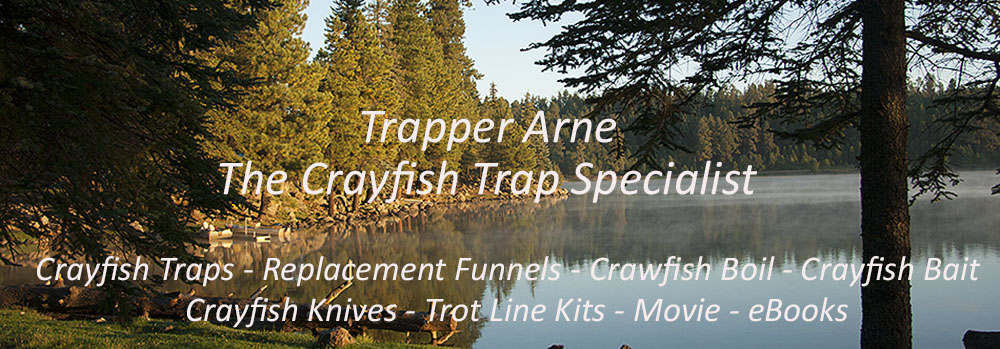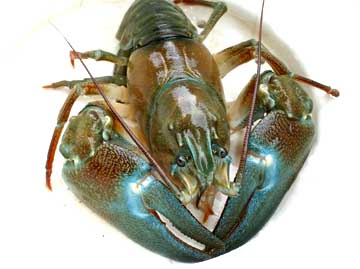
CATCH MORE CRAYFISH WITH TRAPS FROM TRAPPER ARNE

Crayfish are found practically all over the world. As a youngster, I found them in Scandinavia. Swedes and Finns love crayfish, so they are not only found in these countries; they are sincerely cherished. Unfortunately, the Swedish crayfish supplies have been drastically reduced due to a fungal disease called the crayfish pest. As a consequence, large amounts of live California signal crayfish have been exported to Sweden where they thrive. The signal crayfish is resistant to this fungal pest, so many crayfish served in Sweden nowadays are of the signal variety.
Crayfish are found worldwide as numerous different species. Some say as many as 500 species, 330 of which are here in the US. The only continents with no crayfish are Africa and Antarctica. I can understand the latter, but why not in Africa? Africa has many temperate areas where crayfish ought to thrive. Crayfish obviously like it in Australia and Tasmania where they grow to sizes that make Swedes drool. A 16 inch Tasmanian crayfish is as big as many a US lobster.
Although experts on crayfish say there are about 500 species of crayfish with over half of those in the US, the universal interest in catching and eating crayfish is quite spotty. The US is typical. In Europe they have been enjoyed for centuries, while in Turkey, for instance, crayfish are either left alone or exported to Sweden.
Much to the dismay of Europeans who like to eat crustaceans, especially the Swedes and Finns, the quickly spreading crayfish pest appears to have been introduced from the Americas. It is speculated that American crayfish in 1860 were brought to Italy in the ballast water of ships. It has since been determined that the American signal crayfish, although resistant to the crayfish pest, actually carries the pest fungi that soon damaged some of the best crayfish waters of Europe.
 A signal crayfish with its typical white spots on the claws - the "signal".
A signal crayfish with its typical white spots on the claws - the "signal".
After the crayfish pest arrived in Scandinavia around 1907, the crayfish lovers there have been on the prowl for varieties that are less susceptible to the pest than their native species. Now most crayfish catches in Sweden come from the transplanted American Signal crayfish.
In Germany, where the crayfish pest decimated many crayfish stands,authorities now prohibit the importation of live crayfish, many of which are more agressive than their native species.
The few remaning Noble Crayfish in Sweden are surely on their last remaining decapod legs. In the meantime, Swedes enjoy their Signal crayfish parties in the August moonligt.
So far, there are few US bans on the importation of crayfish from other countries. However, some concerns have been raised about the agressive Rusty crayfish which lately has expanded its domain in the Great Lakes region. As the Rusty crayfish appears to be larger than its native cousins, those who like crayfish don't seem to mind.
Arizona has a ban on transporting live crayfish from the lake where they were caught. By attempting to halt the transportation of live crayfish they hope to prevent the introduction of crayfish to any lake that yet is free of them. My experience with Arizona crayfish tells me this is a case of closing the barn after the horse has escaped.
CRAYFISH IN THE USA
In the United States, every state has some species of crayfish; some are native and some are introduced relatively recently. A US map plotting the spread of crayfish indicates that they are pretty well distributed in our land.

The most famous stand of crayfish is down in Louisiana, where the Cajuns have revered the reddish, long clawed crayfish for a long time. Huge rice paddies double as crayfish reservoirs, and enormous quantities of crayfish, often heaped out on newspapers, are consumed each year. Further north you find other species of crayfish. The Sacramento River is full of the variety called the signal crayfish, a variety that has been exported to Sweden to start a new stand after the native crayfish was hit by the devastating crayfish pest.
In Oregon you will find crayfish in most lakes, notable in the Lake Chinook area, but that is only one of many. The Swedish descendants in Washington are lucky to find crayfish in abundance in their lakes.
For years, friends of mine ordered live crayfish from Wisconsin and Minnesota, where all its Swedish immigrants also enjoyed an abundance of these creatures. As you can see, the country is full of lakes and streams that harbor crayfish, so wherever you live, you'll find plenty of them.
WHERE DO I FIND CRAYFISH IN MY STATE?
Yes, there are crayfish in every state of the Union. But while some waters have plenty, some have hardly any.
In order to help friends of the crayfish to find where to locate them in their state, I have compiled a list of all crayfish waters I currently know of that are reported to contain crayfish. I have searched the internet, I have asked friends and trap customers, and slowly I have built up a listing of states with crayfish lakes and rivers identified by name. In some states I have found many sources of crayfish; in other states very few or even none.
Not surprisingly, I have many suggestions for crayfish lakes in Arizona where I have lived for many years.
Although I have often asked customers to let me know names of rivers and lakes with crayfish, very few have volunteered information. Maybe they want to keep their crayfish spots secret, a sentiment I can understand. But if you, who reads this, wants to add to my list, I'll be more than thankful.
To check my list of crayfish waters in the US
click here to go to my CRAYFISH BY STATE listing
CRAYFISH IN ARIZONA
Crayfish were apparently brought to Arizona with the help of fishermen who used crayfish as bait. Maybe that is why you find varieties native to both Louisiana and northern states here. The crayfish I have found in most Arizona lakes, closely resemble those I knew in Sweden. So far, though, I have not seen a California Signal or Rusty crayfish in Arizona.
Be that as it may, most Arizona lakes now have some crayfish in spite of the fact that most of these lakes did not even exist 75 years ago. When I arrived in Arizona in the early seventies, I found crayfish in the Phoenix canals as well as in the lakes that supply the canals with water from the mountains.
Later, during camping trips around the state, I also found crayfish in lakes on the Navajo Reservation, lakes around Flagstaff, most lakes in the White Mountain Area as well as some lakes around Tucson.
You can find crayfish in rocky areas of both rivers and lakes. Crayfish need places where they can hide, so don't look for them on sandy or smooth lake bottoms. When crayfish molt and shed their shells they are practically defenseless and need a good hiding place or they will be cannibalized by other crayfish. Catching crayfish, I have found, is definitely easier and more productive in lakes. That's where I have caught most of mine.
Crayfish are nocturnal which means that they are more active at night. Take a flashlight with you along the shore of a crayfish lake and you will see their beady little luminous eyes as they sit on rocks waiting for some tidbit to come within reach of their sharp claws. However, I have often caught sizeable amounts of crayfish during daytime hours also, so don't limit your fishing to the nighttime.
But how deep do crayfish go? In the summertime I have found most crayfish within ten feet of the surface, so all strings for my trap floats are about ten feet long. Some research, however, indicates that in cold waters crayfish can be found in deeper waters. And when winter sets in, crayfish tend to hibernate under rocks and in burrows while waiting for the next season.
ARE CRAYFISH GOOD OR BAD?
The Arizona Game and Fish authorities have found that crayfish, being non-native, are encroaching on the native wildlife in lakes. While most agree that they are not native, how far back in history you have to go to be classified as native I don't know. As most Arizona lakes are recent constructions, I think it is fair to believe that crayfish have been recently imported to the state. Whether they are good or bad to our ecology, they are considered a competitor to the also non-native and recent import, the rainbow trout. And guess who wins out? The trout of course, as there are many more fishermen who savour the fish than the crustacean.
And because Arizona crayfish have been determined to be non-native, there is a kind of vendetta going on against this crustacean. When I arrived in Arizona there were crayfish in practically every lake I visited and I enjoyed every one of them I caught. So to me they are practically native and good on any table.
Now there is an attempt to reduce the number of crayfish in Arizona lakes by encouraging people to catch and eat as many of these non-native creatures as possible. As crayfish are accused of eating too much of the nutrients that trout live on, no wonder people get on the side of the trout. Except me. Personally, I don't think that we will ever get rid of crayfish anywhere without drastic poisonous methods which all fortunately are against.
